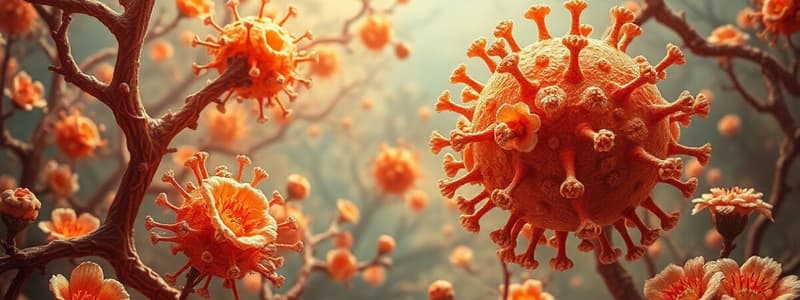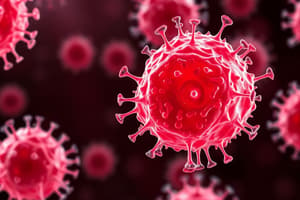Podcast
Questions and Answers
What is the basic structure of the T cell receptor?
What is the basic structure of the T cell receptor?
- Two identical alpha chains
- Two identical beta chains
- Three monovalent chains
- One alpha chain and one beta chain (correct)
Which process ensures that T cell receptors are appropriate for the host's MHC?
Which process ensures that T cell receptors are appropriate for the host's MHC?
- Positive selection (correct)
- Negative selection
- Gene rearrangement
- Clonal expansion
Which of the following correctly describes CD3 in T cells?
Which of the following correctly describes CD3 in T cells?
- An exclusive component of B cell receptors
- Only expressed on activated T cells
- A component of the T cell receptor complex that mediates activation (correct)
- A polymorphic receptor present only on CD8 T cells
What type of genetic arrangement occurs at the T cell receptor gene loci?
What type of genetic arrangement occurs at the T cell receptor gene loci?
Which of the following describes a potential outcome of negative selection in the thymus?
Which of the following describes a potential outcome of negative selection in the thymus?
Which aspect of T cell development primarily occurs in the thymus?
Which aspect of T cell development primarily occurs in the thymus?
How does allelic restriction differ from MHC class restriction in T cells?
How does allelic restriction differ from MHC class restriction in T cells?
What is the relationship between T cell receptor specificity and major T cell subclasses?
What is the relationship between T cell receptor specificity and major T cell subclasses?
What is the primary function of positive selection in T cell development?
What is the primary function of positive selection in T cell development?
Which T cell subset is primarily restricted to MHC class I?
Which T cell subset is primarily restricted to MHC class I?
How does negative selection contribute to self-tolerance in T cells?
How does negative selection contribute to self-tolerance in T cells?
What is the role of MHC molecules in T cell activation?
What is the role of MHC molecules in T cell activation?
What characterizes the allelic variation of MHC molecules in a population?
What characterizes the allelic variation of MHC molecules in a population?
Which cytokine can induce the expression of MHC class II molecules on other cells?
Which cytokine can induce the expression of MHC class II molecules on other cells?
What is the significance of affinity selection for TCRs during thymic development?
What is the significance of affinity selection for TCRs during thymic development?
Which characteristic applies to both CD4+ and CD8+ T cells?
Which characteristic applies to both CD4+ and CD8+ T cells?
What is primarily recognized by T cell receptors during immune response?
What is primarily recognized by T cell receptors during immune response?
Which T cell subtype is primarily involved in promoting B cell activation?
Which T cell subtype is primarily involved in promoting B cell activation?
What determines the class of MHC molecule a T cell receptor recognizes?
What determines the class of MHC molecule a T cell receptor recognizes?
What leads to the anergy of autoreactive T cells?
What leads to the anergy of autoreactive T cells?
Which of the following activities is a direct function of CD4+ T cells?
Which of the following activities is a direct function of CD4+ T cells?
What is a consequence of the lack of CD40L-CD40 interaction?
What is a consequence of the lack of CD40L-CD40 interaction?
Which class of MHC molecules do CD8+ T cells recognize?
Which class of MHC molecules do CD8+ T cells recognize?
What is the primary role of regulatory T cells (Treg) in the immune system?
What is the primary role of regulatory T cells (Treg) in the immune system?
Flashcards
T cell receptor structure
T cell receptor structure
The T cell receptor (TCR) is made of alpha and beta chains, acting as a monovalent receptor. It is part of a complex with CD3 molecules, which are crucial for signaling.
T cell receptor gene loci
T cell receptor gene loci
The genes for the alpha and beta chains of the T cell receptor are arranged independently, undergoing rearrangements to form unique receptors.
Positive selection (T cells)
Positive selection (T cells)
A process in the thymus where T cells with TCRs that recognize self-MHC molecules are selected and allowed to mature.
Negative selection (T cells)
Negative selection (T cells)
Signup and view all the flashcards
MHC restriction
MHC restriction
Signup and view all the flashcards
T cell development pathway
T cell development pathway
Signup and view all the flashcards
MHC diversity
MHC diversity
Signup and view all the flashcards
T cell function
T cell function
Signup and view all the flashcards
Negative Selection of self-reactive TCR
Negative Selection of self-reactive TCR
Signup and view all the flashcards
MHC Molecules
MHC Molecules
Signup and view all the flashcards
MHC Class I
MHC Class I
Signup and view all the flashcards
MHC Class II
MHC Class II
Signup and view all the flashcards
Positive Selection
Positive Selection
Signup and view all the flashcards
T cell subset selection (CD4+/CD8+)
T cell subset selection (CD4+/CD8+)
Signup and view all the flashcards
Self Tolerance
Self Tolerance
Signup and view all the flashcards
Class I MHC Presentation
Class I MHC Presentation
Signup and view all the flashcards
Class II MHC Presentation
Class II MHC Presentation
Signup and view all the flashcards
CD4+ T cells
CD4+ T cells
Signup and view all the flashcards
CD8+ T cells
CD8+ T cells
Signup and view all the flashcards
T cell Activation
T cell Activation
Signup and view all the flashcards
Anergy
Anergy
Signup and view all the flashcards
T Cell Subtypes
T Cell Subtypes
Signup and view all the flashcards
Study Notes
Adaptive Immunity III: Clonal Selection Theory and T Cell Development
- T cell antigen receptor gene loci are arranged in a general germline fashion
- T cell receptors have a specific structure and are expressed on the cell surface
- Positive and negative selection events in the thymus influence T cell receptor repertoire and impose MHC restriction
- MHC molecules exhibit diversity at individual and population levels
- The relationship between the MHC antigen presentation pathway, T cell receptor specificity, and major T cell subsets is described
- Major T cell functions and their relationship to receptor specificity are listed
- The differences between MHC class restriction and allelic restriction for T cells are explained
T Cell Receptor Structure
- The clonotypic receptor is composed of alpha and beta chains, making it monovalent
- The receptor is associated with CD3 signaling molecules, forming a complex
- CD3 is non-polymorphic and found on all T cells
- The complex senses receptor binding and initiates activation signaling
Germ-Line Configuration of T Cell Receptor Genes
- Independent gene rearrangements occur in alpha and beta loci
- Pairing of alpha and beta chains occurs after rearrangements
- Germ-line DNA undergoes recombination to form functional T cell receptors
T Cell Development
- T cell progenitors leave the bone marrow and travel to the thymus, becoming thymocytes.
- Key events in T cell development within the thymus include: gene rearrangement, TCR expression, positive selection (appropriate TCR for host MHC), and negative selection(self-reactive TCR)
- T cells develop through various stages: double-negative, double-positive, and single-positive.
MHC Molecules - Classes, Categories, and Alleles
- MHC molecules are categorized into class I and II
- MHC class I molecules are expressed on all nucleated host cells
- MHC class II molecules are mostly expressed on specialized antigen-presenting cells
- MHC molecules have diverse allelic variants within a population
Effects of Thymic Selection
- Positive selection ensures interaction with self-MHC molecules (MHC restriction)
- T cell subset selection is based on TCR binding to MHC class I (CD8+) or II (CD4+)
- Negative selection deletes autoreactive T cells (self-tolerance)
- The selected T cell repertoire has a narrow range of affinities for self-MHC molecules
What Makes T Cells Work?
- Affinity for self-MHC meets a threshold for selection and survival in the thymus, creating T lymphocytes with receptors specific for the host's MHC alleles
- A diverse T cell receptor repertoire ensures that when a foreign peptide binds to an MHC molecule, the affinity of some T cell receptors will increase above the threshold for activation
- Activation leads to proliferation, differentiation, and acquisition of effector functions
Function of T Cell Matched to Class of MHC Restriction
- MHC class I molecules present endogenous antigens, interacting with CD8+ T cells (cytotoxic T cells)
- MHC class II molecules present exogenous antigens, interacting with CD4+ T cells (helper T cells)
- Different types of CD4+ T cells coordinate the immune response
What Does MHC Restriction Look Like?
- Peptides bind to specialized grooves in MHC molecules.
- Longer grooves in MHC class II bind longer peptides
- T cell receptors recognize peptides and polymorphic residues on MHC molecules
Regulation of Autoreactive B and T Cells not Deleted
- Autoreactive B cells may be denied helper T cell aid leading to B cell anergy
- Autoreactive T cells may not be able to engage specialized APCs,leading to T cell anergy.
- In cases where mechanisms for preventing autoreactivity fail, interventions may sometimes be needed.
Summary
- Naïve T cells leave the thymus expressing CD3, CD4 or CD8 and a T cell receptor
- Selection processes impose MHC restriction and self-tolerance
- T cell expression of CD4 or CD8 defines the class of MHC molecules it recognizes
- T cell functions are associated with the recognized MHC class
- Specialized antigen-presenting cells are vital for naïve T cell activation
- Cell-to-cell contact is essential for activated helper T cells and B cells to produce isotype switching and somatic hypermutation.
Studying That Suits You
Use AI to generate personalized quizzes and flashcards to suit your learning preferences.




